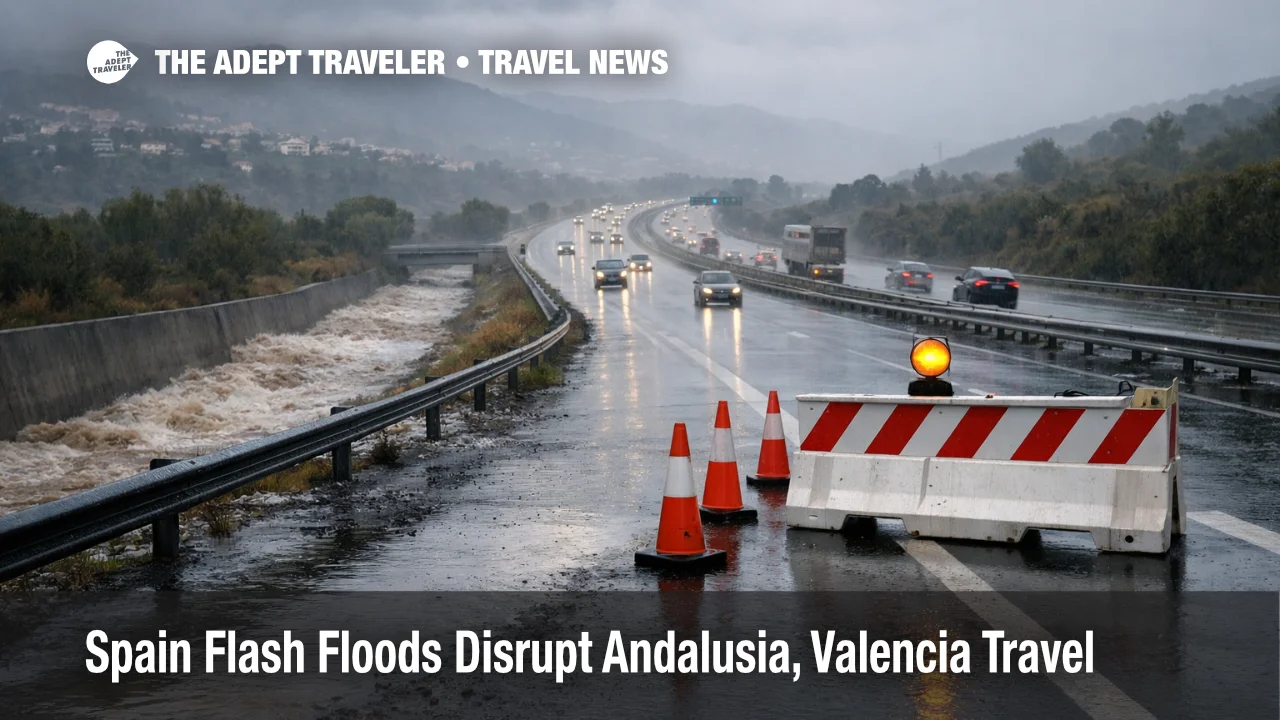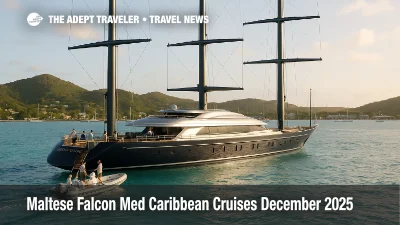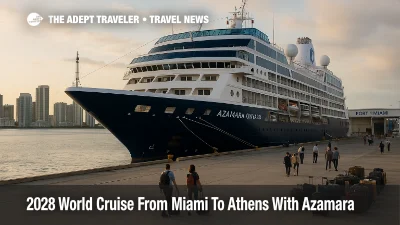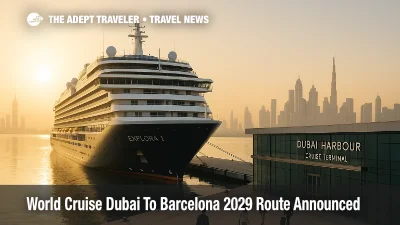Palma de Mallorca, Spain
Nestled on the stunning southern coast of the Balearic Island, travel to Palma de Mallorca is like stepping into a vibrant mosaic of history, culture, and luxurious Mediterranean allure. Palma de Mallorca, Spain, offers an unforgettable journey through its timeless charm, from the towering Gothic spires of La Seu Cathedral to the bustling avenues lined with tapas bars, upscale boutiques, and atmospheric cafés. Whether you're meandering through the ancient streets of the old town, soaking up the sun on picturesque beaches, or savoring the island's exceptional cuisine, this destination intertwines the past with the present in a way that continually enchants visitors. The azure waters and pristine sands beckon to beach lovers, while the vibrant nightlife and burgeoning art scene satisfy even the most discerning traveler. Beyond the city's core, excursions into the rugged Tramuntana mountains or the crystal-clear waters of the nearby coves and islets offer a retreat into natural beauty. Travel to Palma de Mallorca, Spain, and immerse yourself in a tapestry of experiences, each more enchanting than the last. Rich in cultural festivities, historic landmarks, and breathtaking landscapes, Palma de Mallorca is not just a destination; it is an experience that captures the heart and soul of every visitor, making it an unparalleled choice for your next travel adventure.
The History of Palma de Mallorca, Spain
Travel to Palma de Mallorca, Spain, and immerse yourself in a place where rich history meets stunning Mediterranean vistas. Founded in 123 B.C. by the Romans, Palma de Mallorca offers a tapestry woven with Roman, Byzantine, and Moorish influences. Walking through its ancient streets feels like stepping back in time, while the modern-day hustle and bustle provide a captivating contrast. If you're a history buff or simply appreciate the allure of the past, Palma de Mallorca is your perfect travel destination.
The Roman Beginnings
In ancient times, Palma de Mallorca was a significant Roman outpost known as "Palma". Established in 123 B.C., it quickly became a vital point for Roman military operations and trade routes. The Romans recognized the strategic importance of Palma’s location on the Mediterranean Sea, transforming it into a bustling hub of commerce and culture. Today, you can still explore remnants of this era, such as the Roman ruins scattered throughout the city, which paint a vivid picture of life in ancient times. When you travel to Palma de Mallorca, Spain, you are not just visiting a city; you are stepping into a living museum filled with stories from centuries ago.
Moorish Influence and Architectural Marvels
The history of Palma de Mallorca, Spain, takes an intriguing turn with the arrival of the Moors in 902 A.D. Their rule lasted for over 300 years, significantly influencing the city’s architecture, culture, and social fabric. Wander through the old quarter and find yourself surrounded by intricate Moorish designs, from the winding streets of the Arab Baths to the remnants of ancient palaces. The Almudaina Palace is a striking example of the harmonious blend of Roman and Moorish architecture. Many visitors are mesmerized by the unique fusion of styles that beautifully encapsulate this historical period, making travel to Palma de Mallorca an enticing journey through time.
The Gothic Splendor
One cannot travel to Palma de Mallorca without marveling at the stunning Gothic architecture that emerged after the Christian reconquest in 1229. The crowning jewel of this era is La Seu, the Cathedral of Santa Maria of Palma. Perched majestically along the city's coastline, La Seu took nearly 400 years to complete and stands as a testament to gothic artistry. Inside, you'll find elements added by the famous architect Antoni Gaudí at the turn of the 20th century. The towering buttresses, kaleidoscopic stained glass, and intricate sculptures make a visit to this magnificent edifice an unforgettable experience.
Modern History and Cultural Revival
Moving towards the modern era, Palma de Mallorca, Spain, has seen significant cultural and economic revival. In the 20th century, the city transformed into a vibrant tourist hotspot while managing to preserve its historical essence. Dive into the bustling markets, such as Mercat de l’Olivar, where the lively atmosphere is steeped in tradition. Additionally, the city offers a range of museums, such as the Es Baluard Museum of Modern and Contemporary Art, which highlights the ongoing cultural richness that complements its historical depth. This seamless blend of the old and the new makes Palma de Mallorca an enticing travel destination for those enchanted by history yet excited about contemporary culture.
The Culture of Palma de Mallorca, Spain
The vibrant culture and welcoming people of Palma de Mallorca, Spain, offer travelers a richly diverse and immersive experience that is sure to captivate and enchant. Travel to Palma de Mallorca, and you will find a city brimming with history, tradition, and modern touches all meshed together seamlessly. Nestled on the island of Mallorca, the capital city serves as a cultural melting pot that has been influenced by various civilizations over centuries, including the Romans, Moors, and Catalans. This amazing blend of cultural influences is what makes Palma de Mallorca a must-visit destination.
Historical and Cultural Heritage
One of the most compelling reasons to travel to Palma de Mallorca is its historical and cultural heritage. Start your journey by exploring the awe-inspiring Gothic Cathedral of Santa Maria, also known as La Seu. Its stunning architecture and intricate details are bound to leave you speechless. Just a stone's throw from the cathedral is the Royal Palace of Almudaina, an ancient fortress that has stood the test of time and offers a glimpse into the island's Moorish influences. Wandering through the narrow, cobblestone streets of the Old Town, you'll encounter beautifully preserved mansions, hidden courtyards, and historical landmarks that tell the story of Palma de Mallorca's rich past.
A Culinary Journey
Your travel to Palma de Mallorca, Spain, wouldn’t be complete without indulging in its delectable local cuisine. The culinary scene here is a delightful fusion of traditional Spanish flavors and modern culinary techniques. Be sure to visit a traditional market like Mercat de l'Olivar or Mercat de Santa Catalina, where you can savor fresh, local produce and Mallorcan specialties such as sobrassada, ensaïmada, and tumbet. For a fine dining experience, Palma offers numerous Michelin-starred restaurants that creatively reinterpret Mallorcan dishes. Whether you're dining in a rustic tavern or a chic eatery, the gastronomic delights of Palma de Mallorca will surely tantalize your taste buds.
Vibrant Festivals and Events
Another excellent reason to travel to Palma de Mallorca is to experience its vibrant festivals and events. The city hosts a myriad of celebrations throughout the year, each offering a unique glimpse into the local culture. One of the biggest events is Sant Joan, a midsummer festival that features bonfires, fireworks, and a lively party atmosphere. In January, the city comes alive with the Festes de Sant Sebastià, where you can enjoy live music, traditional dances, and street parties. These festivals not only serve as a celebration of Palma de Mallorca's heritage but also foster a sense of community and togetherness that travelers will find heartwarming and unforgettable.
Art and Modern Culture
Beyond its historical roots, Palma de Mallorca is also a thriving hub for contemporary art and culture. The city boasts an impressive array of galleries and museums such as Es Baluard Museum of Modern and Contemporary Art and the Juan March Foundation, both of which showcase works by renowned artists from Spain and beyond. Street art and creative installations can be found throughout the city, adding to its dynamic and modern vibe. The local art scene is complemented by a buzzing nightlife, with an eclectic mix of bars, clubs, and live music venues that ensure your travel experience in Palma de Mallorca, Spain, is as lively and contemporary as it is steeped in history.
The Food of Palma de Mallorca, Spain
Travel enthusiasts and food connoisseurs alike will find an extraordinary culinary experience when they travel to Palma de Mallorca, Spain. This vibrant city, nestled on the stunning Balearic Island of Mallorca, offers a delectable fusion of Spanish, Mediterranean, and local Mallorcan cuisine. From bustling food markets to high-end gourmet restaurants, Palma de Mallorca serves as a haven for taste explorers eager to indulge in an array of delicious flavors and unique dining experiences.
Authentic Mallorcan Cuisine
One of the main draws for travelers to Palma de Mallorca, Spain is its authentic Mallorcan cuisine. Rooted deeply in the island’s rich culture and history, local dishes such as "sobrasada" (a cured sausage made from Balearic black pig) and "ensaïmada" (a sweet pastry made with pork lard) stand out as must-tries. Visitors can dive into pa amb oli, an iconic dish featuring bread, olive oil, and tomatoes, often accompanied by an assortment of cheeses and cured meats. These traditional dishes can be savored in a variety of settings, from charming bistros in the historic center to rustic countryside eateries.
Seafood Extravaganza
Given its prime coastal location, Palma de Mallorca, Spain is a paradise for seafood lovers. Fresh catches from the Mediterranean are prominently featured on numerous menus across the city. Marisquerías and beachfront seafood shacks offer exquisite dishes like "caldereta de langosta" (lobster stew) and "gambas a la plancha" (grilled prawns). Those who travel to Palma de Mallorca are often enchanted by the fish markets such as Mercat de l'Olivar, where they can witness the day’s catch being traded and enjoy vibrant, freshly-prepared seafood platters.
Innovative and Gourmet Dining
For travelers seeking a more refined culinary experience, Palma de Mallorca does not disappoint. The city boasts an impressive array of Michelin-starred restaurants and fashionable gastro-bars where expertly crafted, innovative dishes elevate local ingredients to new heights. Savor a tasting menu at a fine dining establishment like Marc Fosh, where contemporary flavors blend with Mallorcan tradition. The gastronomic scene in Palma de Mallorca is constantly evolving, offering an exciting and dynamic culinary landscape for food enthusiasts to explore.
When you travel to Palma de Mallorca, Spain, you are embarking on a journey through a rich and diverse culinary landscape. Whether feasting on traditional Mallorcan fare, indulging in fresh seafood, or experiencing high-end gourmet cuisine, Palma de Mallorca offers countless opportunities to delight your taste buds. This enchanting destination promises an unforgettable travel experience where every meal is an exploration of flavors and a celebration of the island’s vibrant culinary traditions.
What to See and Do in Palma de Mallorca, Spain
When you travel to Palma de Mallorca, the capital of the Balearic Islands in Spain, you will be greeted by a mix of stunning beaches, historical landmarks, and cultural experiences. Here is a detailed guide to make the most of your trip to Palma de Mallorca, Spain.
1. Explore La Seu Cathedral
No visit to Palma de Mallorca, Spain is complete without exploring La Seu Cathedral, also known as the Cathedral of Santa Maria. This Gothic masterpiece looms over the Parc de la Mar, offering breathtaking views of the Mediterranean. Step inside to marvel at the massive rose window—a stunning feature that casts a kaleidoscope of colors onto the cathedral's interior.
2. Walk Around the Old Town
Stroll through Palma de Mallorca's Old Town, and you'll find yourself surrounded by narrow, cobblestone streets, charming squares, and rustic buildings. This area of Palma de Mallorca, Spain is teeming with history and character, perfect for a leisurely walk or a photography expedition.
3. Visit the Royal Palace of La Almudaina
Adjacent to La Seu Cathedral, you’ll find the Royal Palace of La Almudaina. This ancient fortification dates back to the Muslim Moorish empire and has now been adapted into the summer residence for the Spanish royal family. The palace offers gorgeous gardens, impressive halls, and panoramic views of the city and harbor.
4. Relax at Playa de Palma
If you travel to Palma de Mallorca, make time to unwind at Playa de Palma. This extensive sandy beach, lined with palm trees, is ideal for swimming, sunbathing, and beach sports. Along the promenade, you’ll find numerous bars, restaurants, and shops to explore.
5. Discover the Bellver Castle
Located just a few kilometers from Palma de Mallorca's city center, Bellver Castle offers a unique circular design that is a rare example of Gothic architecture in Europe. Perched on a hill, the castle provides stunning panoramic views of Palma de Mallorca, Spain and its bay. The on-site museum offers historical insights about the castle and the island.
6. Wander Through Mercat de l'Olivar
Immerse yourself in local culture at Mercat de l'Olivar, one of the largest and oldest markets in Palma de Mallorca, Spain. This market is a feast for the senses, featuring a wide array of fresh produce, seafood, meats, cheeses, and an assortment of local delicacies. It’s a great place to capture the local flavor of Palma de Mallorca.
7. Enjoy a Day Trip to Soller
Hop on the vintage wooden train from Palma de Mallorca to the charming town of Soller. This scenic one-hour journey offers picturesque views of the Serra de Tramuntana mountains. Once in Soller, explore its quaint streets, enjoy local cuisine, or take a tram further to the beautiful port area.
8. Dive into History at the Arab Baths
Palma de Mallorca, Spain has a rich Islamic history, evident in the Arab Baths located in the Old Town. These ancient baths date back to the 10th century and are some of the few remnants of the city’s Arab past. Wander through the small garden and soak in the serene atmosphere.
9. Experience Palma Aquarium
Perfect for families and marine life enthusiasts, Palma Aquarium offers an interactive and immersive experience. Home to over 8,000 animals and 700 different species, the aquarium is one of the top attractions in Palma de Mallorca, Spain. Don't miss the Big Blue tank, one of the deepest shark tanks in Europe.
10. Savor Local Cuisine
During your travel to Palma de Mallorca, one must-try experience is indulging in local cuisine. Visit traditional Mallorcan restaurants to enjoy dishes such as "ensaimada" (a sweet pastry), "sobrasada" (a spreadable sausage), and "tumbet" (a vegetable dish akin to ratatouille). The blend of Mediterranean ingredients and local recipes will give you a unique taste of Palma de Mallorca, Spain.
Why You Should Travel to Palma de Mallorca, Spain
Travelers are irresistibly drawn to Palma de Mallorca, Spain, thanks to its enchanting blend of historical charm and modern vibrancy. The city, perched on the Bay of Palma in the Balearic Islands, is renowned for its stunning Gothic architecture, most notably the Cathedral of Santa Maria of Palma, commonly known as La Seu. This architectural masterpiece, towering above the waterfront, offers not just a visual feast but also a journey through centuries of art and history. The narrow, winding streets of the Old Town, lined with medieval buildings, hidden courtyards, and intimate cafés, provide a romantic backdrop for exploration and discovery. Every corner of Palma de Mallorca, Spain, reverberates with stories from its rich past, making it a paradise for history enthusiasts.
Another significant pull for those who travel to Palma de Mallorca is its exquisite culinary scene. The city is a melting pot of traditional Spanish flavors and contemporary gourmet experiences. Travelers can indulge in fresh seafood, authentic tapas, and locally produced wines, while numerous Michelin-starred restaurants elevate dining to a whole new level. Food markets like Mercat de l’Olivar offer an immersive experience where visitors can sample local produce and delicacies. This vibrant food culture is intertwined with Mediterranean influences, making dining in Palma de Mallorca, Spain, an adventure in itself.
Nature lovers who travel to Palma de Mallorca will find themselves surrounded by breathtaking landscapes. The pristine beaches with crystal clear waters are perfect for relaxation and water sports. Beyond the coastline, the Tramuntana Mountain range offers hiking trails with panoramic views of the island. Also worth mentioning are the scenic cycling routes that cater to both casual riders and cycling enthusiasts. The natural beauty of Palma de Mallorca, Spain, provides a serene escape from the daily grind, with opportunities for adventure and tranquility intertwined.
Why You Must Travel to Palma de Mallorca, Spain
Travel to Palma de Mallorca, Spain, is a must for anyone seeking a rich cultural tapestry, culinary adventures, and natural splendor all in one destination. The city's ability to harmoniously blend its historical roots with contemporary lifestyle makes it a unique and desirable place to visit. Whether you are exploring ancient landmarks, dining on world-class cuisine, or basking on sunlit beaches, Palma de Mallorca offers an experience that is both deeply enriching and endlessly enjoyable. This vibrant city promises memories that echo long after you have returned home, making your travel to Palma de Mallorca a journey of a lifetime.
Tips & Tricks for Traveling in Palma de Mallorca, Spain
Travel to Palma de Mallorca, located in the heart of the Balearic Islands, is a delightful blend of cultural richness, stunning beaches, and vibrant nightlife. To ensure your journey to Palma de Mallorca, Spain, is an unforgettable experience, consider these ten essential tips and tricks for an optimized travel experience.
1. Visit During Shoulder Season for Fewer Crowds
Travel to Palma de Mallorca during the shoulder seasons, specifically late spring (May to June) or early autumn (September to October). This timing allows you to enjoy pleasant weather, avoid large tourist crowds, and often find better prices on accommodations and flights. Moreover, exploring the beautiful streets and attractions of Palma de Mallorca, Spain, is more enjoyable without the peak season rush.
2. Rent a Bicycle for Convenient Exploration
One of the best ways to explore Palma de Mallorca is by bicycle. Palma de Mallorca has an extensive network of bike lanes, making it easy to travel around the city while soaking in the picturesque views. Renting a bike allows you to reach hidden gems and navigate through narrow streets quicker than by car or foot.
3. Discover Local Markets
When you travel to Palma de Mallorca, nothing beats the experience of visiting local markets like Mercat de l'Olivar and Mercat de Santa Catalina. These markets are bustling with fresh produce, seafood, and local delicacies. Sampling local foods and interacting with vendors offers a deeper insight into the culinary and cultural fabric of Palma de Mallorca, Spain.
4. Use Public Transportation
Palma de Mallorca has an efficient public transportation system, including buses and trains, that makes travel within the city convenient and affordable. Purchase a TIB or EMT card for discounted fares and easier access to various parts of Palma de Mallorca, Spain. This is a cost-effective way to explore without the hassle of driving and parking.
5. Explore Palma Cathedral and Bellver Castle
No travel to Palma de Mallorca is complete without visiting iconic landmarks like the Palma Cathedral (La Seu) and Bellver Castle. The cathedral’s Gothic architecture and beautiful interiors are awe-inspiring, while Bellver Castle offers panoramic views of Palma de Mallorca, Spain. Both sites provide historical insights and stunning photo opportunities.
6. Embrace the Local Culture
To make the most of your journey, immerse yourself in the local culture of Palma de Mallorca. Participate in festivals such as Sant Joan or Sant Sebastià to experience traditional music, dance, and customs. Additionally, taking a walking tour with a local guide can reveal fascinating stories and lesser-known facts about Palma de Mallorca, Spain.
7. Try Traditional Mallorcan Cuisine
Indulge in traditional Mallorcan cuisine by visiting local restaurants and cafes. Dishes like Tumbet (a vegetable dish), Ensaimada (a sweet pastry), and Frito Mallorquin (fried meat and vegetables) are must-tries. Sampling these local flavors enhances your culinary travel experience to Palma de Mallorca.
8. Plan a Day Trip to Sóller
A scenic train ride from Palma de Mallorca brings you to the charming town of Sóller. The vintage train journey through the Serra de Tramuntana mountains offers breathtaking views and a glimpse of Mallorca’s natural beauty. Exploring Sóller’s quaint streets and its Port adds a unique dimension to your travel itinerary in Palma de Mallorca, Spain.
9. Pack Accordingly for Diverse Activities
When packing for your travel to Palma de Mallorca, ensure you include attire suitable for a range of activities. Lightweight clothing for warm, sunny days, comfortable shoes for walking tours, beachwear, and a light jacket for cooler evenings are essential. This versatility in packing allows you to partake in various activities comfortably.
10. Respect Local Customs and Etiquette
Respecting local customs and etiquette is crucial when you travel to Palma de Mallorca, Spain. Basic courtesies such as greeting in the local language (a simple “hola” goes a long way), dressing modestly when visiting religious sites, and being considerate of local dining customs can significantly enhance your travel experience in Palma de Mallorca.
By employing these tips and tricks, your travel to Palma de Mallorca promises a blend of adventure, relaxation, and cultural enrichment. The charm and diversity of Palma de Mallorca, Spain, await every traveler looking to create lasting memories.
Other Places You Might Like
If you love Palma de Mallorca, Spain, you'll likely find yourself enchanted by other travel destinations that share similar qualities, such as beautiful beaches, rich histories, vibrant cultures, and breathtaking landscapes. Here are some cities that people who enjoy Palma de Mallorca will also love.
Barcelona, Spain - Combining cosmopolitan vibrancy with astounding historical and architectural landmarks, Barcelona is a perfect destination for travelers who adored Palma de Mallorca. Travel through its bustling streets, marvel at the Sagrada Familia, or unwind at the beaches of Barceloneta. Like Palma de Mallorca, Barcelona offers a blend of seaside relaxation and cultural indulgence.
Dubrovnik, Croatia - Known as the "Pearl of the Adriatic," Dubrovnik captivates visitors with its stunning coastline, well-preserved medieval architecture, and rich history. Stroll through the ancient city walls, enjoy panoramic views from Mount Sr?, or relish the sun on the pristine beaches. The city's mix of historical charm and natural beauty echoes the allure found when you travel to Palma de Mallorca, Spain.
Valletta, Malta - Valletta is a captivating blend of historical intrigue and modern comforts. Visitors can wander through narrow streets framed by ancient limestone buildings, visit the grand St. John's Co-Cathedral, and lounge on the scenic Mediterranean shoreline. Much like Palma de Mallorca, this UNESCO World Heritage Site offers a sophisticated blend of culture, history, and leisure.
Nice, France - Set along the French Riviera, Nice is renowned for its picturesque beaches, lively markets, and elegant architecture. Wander through the Old Town's narrow lanes, visit the Matisse Museum, or enjoy a leisurely stroll on the Promenade des Anglais. With its blend of seaside beauty and cultural richness, Nice will resonate strongly with those who loved their travel to Palma de Mallorca.
Santorini, Greece - Known for its iconic whitewashed buildings and stunning sunsets, Santorini offers an enchanting travel experience. Explore the ancient ruins of Akrotiri, relax on unique volcanic beaches, or simply soak in the breathtaking views from Oia. Like Palma de Mallorca, Santorini provides a mix of historical wonders and scenic beauty that travelers will treasure.
Antalya, Turkey - Often referred to as the gateway to Turkey’s southern Mediterranean region, Antalya is a destination filled with fascinating historical sites and beautiful beaches. Walk through the ancient city of Kaleici, visit the Antalya Museum, or bask on the sun-drenched shores of Konyaalt? Beach. The city’s rich history and gorgeous landscapes make it a delightful alternative for those reminiscing about their travel to Palma de Mallorca, Spain.
Lisbon, Portugal - Lisbon’s vibrant culture, historic neighborhoods, and stunning views over the Tagus River make it a captivating destination. Enjoy the nightlife in Bairro Alto, explore the majestic Jerónimos Monastery, or take a tram ride through Alfama. With its blend of history and seaside charm, Lisbon provides an engaging experience similar to that of Palma de Mallorca.
Porto, Portugal - Famous for its port wine and stunning riverfront, Porto is a city that merges old-world charm with contemporary attractions. Walk along the scenic Douro River, visit the enchanting Livraria Lello, or enjoy a river cruise. Porto’s rich history and welcoming atmosphere make it a compelling destination for those who enjoyed Palma de Mallorca, Spain.
Cinque Terre, Italy - This string of five picturesque villages along the Italian Riviera offers breathtaking coastal views, vibrant architecture, and a tranquil atmosphere. Hike the scenic trails connecting the villages, sample fresh seafood, or relax on the pebbly beaches. Much like Palma de Mallorca, Cinque Terre’s combination of natural beauty and cultural richness creates an unforgettable travel experience.
Split, Croatia - Known for its stunning Adriatic views and ancient Roman architecture, Split is a city where history and modernity coexist harmoniously. Explore the UNESCO-listed Diocletian's Palace, enjoy a trip to the nearby islands, or relax on the city's beaches. With its rich heritage and seaside allure, Split offers an experience reminiscent of Palma de Mallorca, Spain.
Spain Flash Floods Disrupt Andalusia, Valencia Travel

Spain Azul Handling Strikes Delay Baggage at Airports

London Airport Strikes Disrupt Christmas Flights

MSC Magnifica World Cruise 2028 Booking Details

A&K - Crystal 2027 Cruise Dates for Europe, New York

Spain Airbnb Fine Hits Tourist Rental Listings

Tarifa Tangier Ferries Canceled in Gibraltar Winds

Azul Handling Strike Spain Airports Through Dec 31

Barbados And Spain Lead 2026 Villa Trends

Spain Airport Handling Strike Days Through December 31

Schengen Internal Border Checks Widespread In Late 2025

Europe Air Traffic Control Delays Worsen, Add Buffers

Ground Handling Walkouts Hit Spain Airports Through Dec 31

Portugal General Strike Cuts Flights And Trains Dec 11 2025

Europe December Strikes Hit Holiday Flights And Trains

Spain Doctors Strike Cuts Hospital Care Dec 9 12

Maltese Falcon Med Caribbean Cruises December 2025

Spain Flu Surge Brings Hospital Mask Rules

Europe 2025 Travel Rules Tighten Borders And Costs

2028 World Cruise From Miami To Athens With Azamara

Spain Iryo Rail Strike To Hit Madrid Routes Dec 5 8

New Melbourne Doha Flights Expand Europe Options

2027 Mediterranean Season Adds Egypt Yacht Voyages

Roam 2026 Tours Open For Bookings In Mexico, Europe

World Cruise Dubai To Barcelona 2029 Route Announced

